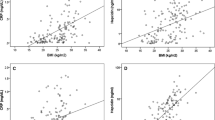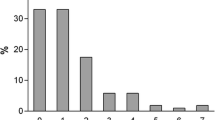Abstract
Serum iron (sFe), and ferritin (sFert), transferrin saturation index (TSI), plasma zinc and copper (pZn, pCu), and erythrocyte zinc content (eZn) were measured in 55 obese children and adolescents (28 males and 27 females) before and after a 13-wk treatment with a hypocaloric balanced diet (HCBD, 22 subjects) or a 10-wk treatment with a protein sparing modified fast diet (PSMF, 33 subjects). The energy intake provided by the HCBD and PSMF diet was calculated to be 60 and 25%, respectively, of the recommended dietary allowances (RDAs) for age and sex. Neither diet was supplemented with trace elements or calcium.
Using a visual memory system, all subjects had a 24-h dietary intake recall before starting the weight-loss program. Iron, zinc, and copper intakes from the 24-h recall were compared with those from prescribed diets.
Both diets produced a significant (p<0.001) weight reduction with a significant reduction in the arm muscle area of the PSMF group.
After treatment, no significant change was observed in sFe, sFert, and TSI of either group, whereas eZn increased significantly in the HCBD and the PSMF groups (p=0.001 andp<0.006, respectively), with an improvement of the erythrocyte index (E.I.). A significant increase in pZn was also observed in the PSMF group (p=0.007).
When compared with the usual intakes, HCBD supplied less iron (p=0.04) and more copper (p=0.001), whereas PSMF provided more zinc (p=0.026).
Similar content being viewed by others
References
C. Catassi, I. M. Ratsch, M. Rossini, A. G. Ruggeri, G. V. Coppa, and P. L. Giorgi, Treatment of childhood obesity by a protein sparing diet: a clinical and metabolic study, inThe Obese Child, P. L. Giorgi, R. M. Suskind, and C. Catassi, eds., Karger Basel, pp. 197–205 (1992).
R. Figueroa-Colon, K. T. Von Almen, and R. M. Suskind, Clinical considerations in the treatment of childhood obesity, inThe Obese Child, P. L. Giorgi, R. M. Suskind, and C. Catassi, eds., Karger Basel, pp. 181–196 (1992).
R. Figueroa-Colon, K. T. Von Almen, and R. M. Suskind, Treatment of childhood obesity, inTextbook of Pediatric Nutrition, II, R. M. Suskind and L. Suskind, eds., Raven, New York, pp. 285–294 (1993).
M. Caroli, S. Chiarappa, R. Borelli, and R. Martinelli, Efficiency and safety of using protein sparing modified fast in pediatric and adolescent obesity treatment,Nutr. Res. 12, 1325–1334 (1992).
P. J. Agget, The diagnostic value of measurements for trace elements in biological material, inInfantile Nutrition—An Update, Contribution to Infusion Therapy, R. Di Toro, ed., Karger Basel, pp. 53–65 (1991).
A. R. Frisancho,Anthropometric Standards for the Assessment of Growth and Nutritional Status, The University of Michigan Press, Ann Arbor (1990).
R. J. Merrit, B. R. Bistrian, G. L. Blackburn, J. Palomb, and R. M. Suskind, Consequences of modified fasting in obese pediatric and adolescent patients: effect of a cho-free diet on serum proteins,Am. J. Clin. Nutr. 34, 2752–2755 (1981).
T. G. Lohman, A. F. Roche, and R. Martorell. Manuale di riferimento per la standardizzazione antropometrica, Milano, EDRA Italy (1992).
R. M. Malina, P. V. V. Hamill, and S. Lemeshow, Selected measurements of children 6–11 years. United States Vital and Health Statistics Series 11, USDHHS publication 123. US Government Printing Office, Washington (1973).
W. H. Mueller, S. K. Joos, and W. J. Schull, Alternative measurements of obesity: accuracy of body silhouettes and reported weights and heights in a Mexican American sample,Int. J. Obes. 9, 193–196 (1985).
R. Moro, G. Gialanella, R. Di Toro, L. Perrone, and V. Giordano, Zinc determination in erythrocytes by a colorimetric method,Trace Element Med. 5, 123–125 (1988).
A. Iolascon and L. Perrone, Erythrocytic zinc content during childhood,Acta Haematol 73, 114–116 (1985).
Istituto Scotti Bassani, Atlante Ragionato di Alimentazione. Istituto Scotti Bassani per la ricerca e l'informazione scientifica e nutrizionale, Milano (1989).
G. C. Frank, G. S. Berenson, P. E. Schilling, and M. C. Moore, Adapting the 24-hr. recall for epidemiologic studies of school children.J. Am. Diet. Assoc. 71, 26–31 (1977).
Food and Nutrition Board,Recommended Dietary Allowances, 10th ed., National Academy Press, Washington, DC (1989).
M. R. Suskind, M. Caroli, and C. Shasma, Obesity, inNutrition in Preventive Pediatrics, Contribution to Infusion Therapy, R. Di Toro, ed., Karger, Basel, pp. 62–79 (1989).
M. R. Brown, W. J. Klish, J. Hollander, M. A. Campbell, and G. B. Forbes, A high protein, low calorie liquid diet in the treatment of very obese adolescents: Long term effect on lean body mass,Am. J. Clin. Nutr. 38, 20–31 (1983).
K. M. Hambidge and P. A. Walravens, Zinc deficiency in infants and preadolescent children, inTrace Elements in Human Health and Disease, A. Prasad, ed., Academic, New York, pp. 21–32 (1976).
J. E. Stuff, C. Garza, E. O'Brian Smith, B. L. Nichols, and C. M. Montandon, A comparison of dietary methods in nutritional studies,Am. J. Clin. Nutr. 37, 300–306 (1983).
R. K. Chandra and K. M. Kutty, Immunocompetence in obesity,Acta Paediatr. Scand. 69, 25–30 (1980).
C. M. Der, L. P. Yao, W. H. Lin and V. Cheng, Zinc in hair and serum of obese individuals in Taiwan,Am. J. Clin. Nutr. 48, 1307–1309 (1988).
A. Marotta, N. Todisco, A. Di Toro, R. Toraldo, G. Ponte, and L. Perrone, Zinc content of lymphomonocytes in obese children.Nutr. Res. 19, 1411–1415 (1995).
P. J. Collipp, New developments in medical therapy of obesity: Thyroid and zinc,Pediatr. Ann. 13, 465–472 (1984).
Author information
Authors and Affiliations
Rights and permissions
About this article
Cite this article
Di Toro, A., Marotta, A., Todisco, N. et al. Unchanged iron and copper and increased zinc in the blood of obese children after two hypocaloric diets. Biol Trace Elem Res 57, 97–104 (1997). https://doi.org/10.1007/BF02778192
Received:
Accepted:
Issue Date:
DOI: https://doi.org/10.1007/BF02778192




